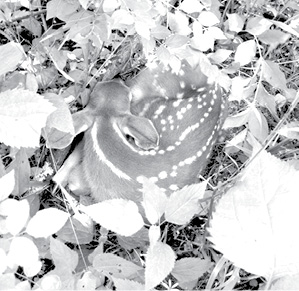Kentucky Afield Outdoors: Young wildlife should be left alone

Recently, a photo of a wild bison calf standing in the back of an SUV at Yellowstone National Park made national news after first going viral on social media.
The story illustrated an extreme scenario of compassion blurring common sense as the well-intentioned tourists took it upon themselves to “help” the bison calf out of concern for its welfare.
The Information Center at Kentucky Department of Fish and Wildlife Resources headquarters answers about 100,000 phone calls and tens of thousands of emails each year. Springtime brings a flurry of communications about young wildlife thought to be orphaned, abandoned or in danger.
As a general rule, department biologists recommend leaving these wild animals alone. Keeping your distance increases the chances the mother will return to them and life will go on as nature intended. This goes for songbirds that have fledged from the nest and are learning to fly as well as white-tailed deer fawns concealed in thick cover.
They may look adorable, but they do not make good house pets and should be left where they were found. Only permitted wildlife rehabilitators may possess injured or orphaned wildlife, and only persons with a captive cervid permit may keep deer in captivity.
Reports of white-tailed deer fawns thought to be abandoned are common in May and June. That makes sense because the timeframe coincides with the peak of fawning season.
“They are hitting the ground right now,” said Gabe Jenkins, deer and elk program coordinator with Kentucky Fish and Wildlife.
Newborn deer spend much of their time bedded down until they build up enough strength to keep up with their mother. Their reddish-brown coat patterned with pale spots aids in their concealment.
“Fawns have a mind of their own and may pick up and move,” Jenkins said. “They can be anywhere. They’re naïve and don’t know what to fear. I’ve heard of them hiding in people’s garages, the bushes, in their shrubs. They’re just looking for cover and a good hiding spot.”
Often these fawns are found by people who do not see the mother. In reality, the mother likely is not far away. The mother also may distance herself to draw a predator’s attention away from the vulnerable young animal.
In cases when a fawn is visibly injured, has been calling for its mother for hours on end, or if the mother has been hit by a car, it’s appropriate to take action.
“Another example would be if a fawn can’t get to its mother. Maybe it’s hopped a fence and now it can’t get back and the mother can’t get it back. That happens a lot,” Jenkins said. “You can contact us or visit our website and find a rehabilitator.”
A searchable list of permitted wildlife rehabilitators is available on Kentucky Fish and Wildlife’s website at fw.ky.gov. Click on the “Wildlife” tab and choose “Injured & Orphaned Wildlife” from the dropdown menu.
“More than likely, unless you know its mother has died, the fawn is doing fine,” Jenkins said. “They’re not abandoned. She’ll come back for them. She’ll come back to the spot where she last saw it. If it’s not there, she’ll search and sometimes they’ll do a vocalization trying to call them back.”
Landowners may encounter deer fawns and ground-dwelling birds and other mammals while mowing fields or walking around their property. Hunters who want to conserve wildlife might want to consider cutting back on their mowing until later in the season, Jenkins said.
“Fawns are going to lie out in the fields for the first two weeks after they are born,” he said. “A lot of animals use grasslands, many are species of concern and of high importance, and mowing during the breeding season can be detrimental.”
Rabbits may continue nesting into the summer months. Homeowners who discover nesting rabbits in their yard might consider placing a flag or other marker to provide a visual cue to avoid that spot when mowing.
From rabbit nests to newly fledged birds to white-tailed deer fawns found curled up in cover and more, resist the urge to take matters into your own hands. Nature knows best how to handle its own.
